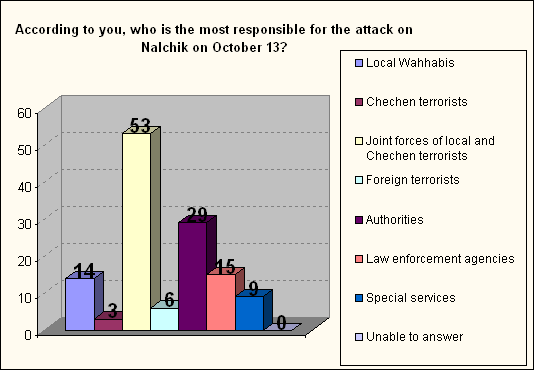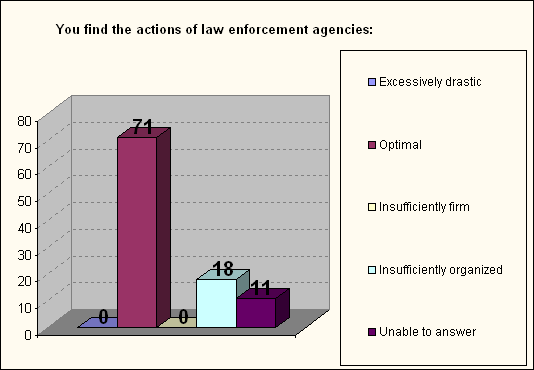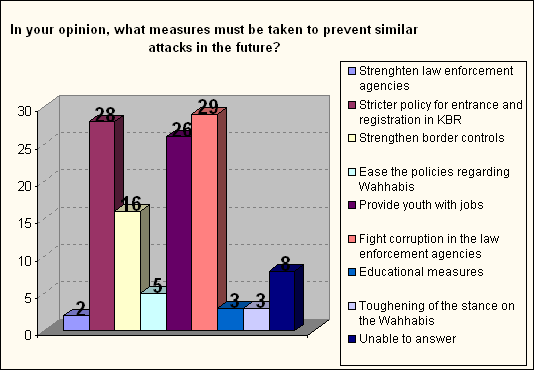Results of survey carried out in Nalchik after the October 13 attacks53% of those surveyed blame ”local Wahhabis and Chechen terrorists” for the attack on Nalchik.
(Caucasus Times) - From October 18 to 21, 2005, the Caucasus Times conducted a brief survey in Nalchik, capital of Kabardino-Balkaria, of people ranging from 16 to 65 years of age.
The aim of the study was to get people’s perspective about the October 13th attack on the city.
The survey revealed many diverse opinions regarding the question of who bears the primary responsibility for the attack, and also assessing the actions of the local law-enforcement agencies that 71% felt were "optimal." Throughout the survey, respondents were open, helpful and somewhat emotional, indicating a psychological need to share their views on painful and long-neglected problems.
Responding to the question of who is primarily responsible for the attack, 53% said it was the joint forces of the “local Wahhabis and Chechen terrorists”. Yet 29% laid the blame on the authorities; 15% on law-enforcement agencies; and 14% on local Wahhabis. However, people also mentioned special services (9%), foreign terrorists (6%) and Chechen terrorists (3%). It must be noted that no one was averse to answering this question.
Many people were very vocal in assessing the actions of law enforcement agencies during the attack. An overwhelming majority (71%) described the actions as "optimal," while 18% found them "insufficiently organized". None of those interviewed felt that action of law enforcement agencies was excessively drastic. However, 11% found it difficult to answer this question.
More diverse opinions were given in response to what measures should be taken to prevent similar attacks in the future. It must be noted that 29% listed eliminating corruption in law-enforcement agencies as the main measure. This shows that although in this specific situation 71% evaluated actions of law enforcement agencies as optimal, in general a substantial 29% thinks the law enforcement agencies are corrupt.
Almost the same percentage (28%) supported the idea of applying a stricter policy for entrance and registration in the Republic. A large number of those interviewed (26%) mentioned a need to provide employment for young people, thus showing that unemployment is an important cause of terrorism in the region. 16% were in favour of strengthening border control, and 5% wanted an easing of policies regarding the Wahhabis. Supporters of adopting educational measures for Wahhabis and supporters for toughening the stance against them were each 3%. It is interesting to note that a mere 2% were for strengthening law enforcement agencies. 8% had difficulty in answering this question.
The results of this survey demonstrated a high degree of unanimity among the people, both in evaluating actions by law enforcement agencies and in determining those responsible for the attack on the capital of Kabardino-Balkaria. At the same time, they expressed a wide range of opinions about the measures needed for preventing similar attacks in the future. It is important to mention that among these were: 29% for eliminating corruption in law enforcement agencies; 28% for toughening entrance and registration requirements; and 26% for guaranteeing employment for young people.
Islam Tekushev, editor-in-chief of the Caucasus Times
Note: this survey was conducted as part of a 12 month investigative project "Public Opinion in North Caucasus" that is being carried out in all the North Caucasus republics with the financial support of the American foundation NED. Answers to the survey are given as percentages and the statistical error of such surveys is within 7%. Two answers were allowed for some questions. Participants were mainly members of the intelligentsia, students, employees, workers, pensioners, and members of the different ethnic groups that make up the population of Kabardino-Balkaria (Kabardinians, Balkarians, Russians, Ossetians, Chechens, and others).
Charts (answers are in percentages):



Translated by Mindaugas Kojelis/Prague Watchdog.
(MK/E,A,B)
DISCUSSION FORUM
|

